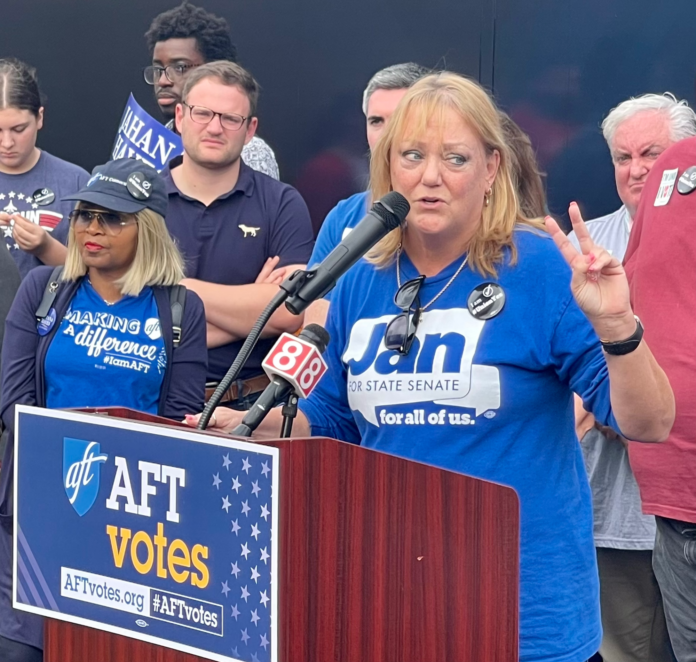Too many classrooms across Connecticut are plagued with environmental conditions that impede teaching and learning. In a recently published op-ed, AFT Connecticut President Jan Hochadel (in photo, below) called out fellow state lawmakers for failing to address this vital public health issue. As a state legislator, she shared why she supported the “Carbon-Free and Healthy Schools Act” and “will be back to fight for its passage next session:”
This summer of smoky haze and extreme heat reminds us that climate change is undeniably a crisis. Unfortunately, Connecticut’s legislature failed to take meaningful action on climate in the 2023 session. One of the biggest missed opportunities was the failure to get Senate Bill (SB) 961, the Carbon-Free and Healthy Schools Act, over the finish line after it passed out of the state Senate with unanimous consent.
Click here to read our AFT Connecticut vice president’s testimony submitted earlier this year in support of the legislation.
SB 961 would have leveraged a state investment of $25 million to establish a new program at the Connecticut Green Bank. The program would help schools carry out cost-cutting energy projects. It would have funded feasibility studies for solar and energy efficiency, provided districts with technical assistance to evaluate and implement projects, provided $400 million in project financing through the Green Bank, and helped districts take advantage of federal funding opportunities including significant tax credits under the Biden administration’s clean energy program.
The cost savings alone are reason enough to implement this program. Districts face a funding cliff as pandemic relief funding runs out. Energy costs are skyrocketing, and energy upgrades create a source of permanent cost savings while improving the educational experience. But the program’s benefits would have been even more wide-reaching.
School buildings are huge consumers of energy, and many rely on aging boilers to heat drafty buildings. Energy efficiency and renewable energy upgrades like weatherization, HVAC improvements, LED lighting, and rooftop solar both save money and reduce greenhouse gas emissions, helping move the state closer to its emissions targets.
Click here for photos of union members and allies at this year’s healthy schools at the State Capitol.
Modernizing school buildings has been shown to have benefits for teacher retention, which is important at a time when many districts are struggling to retain sufficient teaching staff. When these improvements tackle indoor air quality by removing hazards like mold or asbestos to weatherize or improve ventilation, there can be noticeable improvements in public health and a reduction in absenteeism due to asthma and related illnesses.
Reduced teacher turnover and absenteeism, reduced student absenteeism, and reduced classroom distractions (like noisy HVAC, poor lighting, and uncomfortable temperatures) have all been shown to improve academic performance.
Click here for the Connecticut Roundtable on Climate and Jobs’ fact sheet on SB 961.
As an educator, everything I do centers around my students and their well-being. That’s why I supported the Carbon Free & Healthy Schools Act. This bill would have upgraded our public school buildings and created healthy and safe schools for our educators and students.
Energy projects in schools also create living-wage construction jobs and training opportunities for community residents and union workers. By addressing energy improvements on a sector-wide basis, we can train Connecticut residents for long-term careers working on clean energy improvements in the building and construction trades.
The initiative that SB 961 would have created is important to removing common barriers to these improvements, and advocates like me of this bill will be back to fight for its passage next session. In the meantime, there are alternative actions and carbon-free and healthy school funding sources that districts can pursue.
Click here to learn more about additional efforts led by the Connecticut Roundtable on Climate and Jobs.
Through the Solar Municipal Assistance Program, districts can access solar feasibility studies. Districts should also consult with their electric and gas utilities about available incentives for upgrades like LED lighting. Grants departments should keep an eye out for federal opportunities like the Renew America’s Schools program and the EPA Clean School Bus program. If projects are in the planning stage or have been completed since the Inflation Reduction Act passed, districts should talk to their contractors about their eligibility for clean energy and energy efficiency tax credits.
Click here for the original op-ed published in the Connecticut Post.



